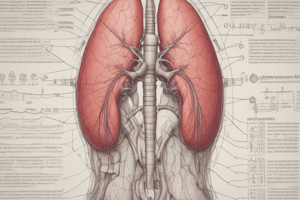Podcast
Questions and Answers
What is the primary function of the renal system?
What is the primary function of the renal system?
- To produce hormones that help regulate body temperature
- To filter waste and excess fluids from the blood (correct)
- To regulate blood pressure
- To store nutrients for energy production
What is the location of the kidneys in the body?
What is the location of the kidneys in the body?
- In the lower abdominal cavity, one on each side of the spine
- In the upper abdominal cavity, one on each side of the spine (correct)
- In the chest cavity, one on each side of the heart
- In the pelvis, posterior to the pubic bone
What is the function of the renal cortex?
What is the function of the renal cortex?
- To produce hormones that help regulate blood pressure
- To regulate electrolyte levels
- To filter waste and excess fluids from the blood
- To contain glomeruli and renal corpuscles (correct)
How many nephrons are approximately present in each kidney?
How many nephrons are approximately present in each kidney?
What is the function of the ureters?
What is the function of the ureters?
What is the function of the bladder?
What is the function of the bladder?
What is the function of the renal arteries?
What is the function of the renal arteries?
What is the function of the urethra in males?
What is the function of the urethra in males?
Flashcards are hidden until you start studying
Study Notes
Overview of the Renal System
- The renal system, also known as the urinary system, is responsible for filtering waste and excess fluids from the blood.
- It consists of two kidneys, two ureters, the bladder, and the urethra.
Kidneys
- Located in the upper abdominal cavity, one on each side of the spine
- Bean-shaped organs, approximately 10 cm in length
- Functions:
- Filter waste and excess fluids from the blood
- Regulate electrolyte levels (e.g., sodium, potassium, calcium)
- Produce hormones that help regulate blood pressure and produce red blood cells
- Maintain acid-base balance
Kidney Structure
- Cortex: outer layer, contains glomeruli and renal corpuscles
- Medulla: inner layer, contains renal pyramids and collecting ducts
- Nephrons: functional units of the kidney, approximately 1 million per kidney
- Consist of glomerulus, Bowman's capsule, and renal tubules
Ureters
- Muscular tubes that connect the kidneys to the bladder
- Approximately 25-30 cm in length
- Function: transport urine from the kidneys to the bladder
Bladder
- Hollow, muscular organ that stores urine
- Located in the pelvis, posterior to the pubic bone
- Functions:
- Stores urine
- Expels urine through the urethra
Urethra
- Tube that connects the bladder to the outside of the body
- Functions:
- Carries urine from the bladder to the outside of the body
- In males, also carries semen during ejaculation
Blood Supply
- Renal arteries: branch off from the abdominal aorta, supply oxygenated blood to the kidneys
- Renal veins: return deoxygenated blood from the kidneys to the inferior vena cava
Overview of the Renal System
- Renal system, also known as the urinary system, filters waste and excess fluids from the blood
- Consists of two kidneys, two ureters, the bladder, and the urethra
Kidneys
- Located in the upper abdominal cavity, one on each side of the spine
- Bean-shaped organs, approximately 10 cm in length
- Functions:
- Filter waste and excess fluids from the blood
- Regulate electrolyte levels (e.g., sodium, potassium, calcium)
- Produce hormones that help regulate blood pressure and produce red blood cells
- Maintain acid-base balance
Kidney Structure
- Cortex: outer layer, contains glomeruli and renal corpuscles
- Medulla: inner layer, contains renal pyramids and collecting ducts
- Nephrons: functional units of the kidney, approximately 1 million per kidney
- Consist of glomerulus, Bowman's capsule, and renal tubules
Ureters
- Muscular tubes that connect the kidneys to the bladder
- Approximately 25-30 cm in length
- Function: transport urine from the kidneys to the bladder
Bladder
- Hollow, muscular organ that stores urine
- Located in the pelvis, posterior to the pubic bone
- Functions:
- Stores urine
- Expels urine through the urethra
Urethra
- Tube that connects the bladder to the outside of the body
- Functions:
- Carries urine from the bladder to the outside of the body
- In males, also carries semen during ejaculation
Blood Supply
- Renal arteries: branch off from the abdominal aorta, supply oxygenated blood to the kidneys
- Renal veins: return deoxygenated blood from the kidneys to the inferior vena cava
Studying That Suits You
Use AI to generate personalized quizzes and flashcards to suit your learning preferences.




